Response of Ecosystem Service Value to LULC Under Multi-Scenario Simulation Considering Policy Spatial Constraints: A Case Study of an Ecological Barrier Region in China
Abstract
1. Introduction
2. Study Area and Data Sources
2.1. Overview of the Study Area
2.2. Data Sources and Processing
3. Methodology
3.1. Assessment of Ecosystem Service Values
3.2. Spatiotemporal Analysis of Ecosystem Service Values
3.2.1. Spatial Autocorrelation
3.2.2. Hot Spot Analysis
3.3. Future Land Use Multi-Scenario Simulation Based on the Markov-PLUS Model
3.3.1. Markov-PLUS Model
3.3.2. Selection of Land Expansion Driving Factors
3.3.3. Accuracy Verification
3.3.4. Multi-Scenario Settings Based on Policy Space Constraints
- (1)
- Natural development scenario (NDs). Without considering human intervention or policy constraints, this scenario leverages historical land use data to model the region’s intrinsic development trajectory. No additional constraints are applied to the conversion processes, and the PLUS model is utilized to forecast land use patterns for 2030, forming the foundation for the analysis of the other two scenarios;
- (2)
- Ecological conservation scenarios (ECs). Through the implementation of the ecological red line policy, China has been enforcing the strict protection of key ecological function areas. In this scenario, for land within the ecological red line, the conversion of forest land, grassland and watershed land types will be strictly controlled, and for land outside the red line control area, the probability of conversion of other land types to forest land will be increased and the loss of forest land will be reduced, in order to meet the requirements for ecological conservation and maximize the ecological benefits of various land use types. Specific adjustments include decreasing the probability of forest land being converted into farmland, grassland, or built-up land by 80%, enhancing the probability of unused land transforming into farmland, grassland, or forest land by 30%, boosting the chance of farmland transitioning to forest land or grassland by 30% while lowering its conversion to built-up land by 30%, increasing the probability of grassland transitioning to forest land by 30% and reducing its shift to built-up land by 30%, and keeping all other conversion probabilities unchanged;
- (3)
- Farmland conservation scenario (FCs). Farmland protection is closely tied to national food security. China’s permanent basic farmland policy ensures the strict preservation of high-quality farmland and stable farming areas, prohibiting their conversion to other land types. In this scenario, the farmland data for YNP from 2005, 2010, 2015, and 2020 are overlaid to identify consistently cultivated areas, representing stable farming lands, while areas with slopes less than 6° are identified as high-quality farmlands. These stable and high-quality farmland areas are designated as restricted zones for conversion (Figure 5). Additionally, the likelihood of conversion from farmland to built-up land outside the boundaries of the restricted area is reduced by 60%, the probability of transition from other land types is kept unchanged, and the conservation of farmland is strictly enforced.
4. Results
4.1. Spatiotemporal Analysis of Land Use/Land Cover Dynamics from 2005 to 2020
4.2. Analysis of Temporal and Spatial Evolution of Ecosystem Service Values in YNP (2005–2020)
4.3. Multi-Scenario Land Use Simulation
4.4. Ecosystem Service Value and Its Changes Under Simulated Scenarios
5. Discussion
5.1. The Response of Ecosystem Service Values to Land Use Changes
5.2. Changes in Ecosystem Service Values Without Consideration of Built-Up Land
5.3. Simulation of Different Scenarios Under Policy Spatial Constraints and Insights into the Future Development of YNP
5.4. Limitations and Future Prospects
6. Conclusions
Supplementary Materials
Author Contributions
Funding
Data Availability Statement
Conflicts of Interest
References
- Qiu, H.; Hu, B.; Zhang, Z. Impacts of Land Use Change on Ecosystem Service Value Based on SDGs Report—Taking Guangxi as an Example. Ecol. Indic. 2021, 133, 108366. [Google Scholar] [CrossRef]
- Guan, Y.; Qiang, Y.; Qu, Y.; Lu, W.; Xiao, Y.; Chu, C.; Xiong, S.; Shao, C. Environmental Sustainability and Beautiful China: A Study of Indicator Identification and Provincial Evaluation. Environ. Impact Assess. Rev. 2024, 105, 107452. [Google Scholar] [CrossRef]
- Zhang, X.; Ren, W.; Peng, H. Urban Land Use Change Simulation and Spatial Responses of Ecosystem Service Value Under Multiple Scenarios: A Case Study of Wuhan, China. Ecol. Indic. 2022, 144, 109526. [Google Scholar] [CrossRef]
- Costanza, R.; d’Arge, R.; de Groot, R.; Farber, S.; Grasso, M.; Hannon, B.; Limburg, K.; Naeem, S.; ONeill, R.V.; Paruelo, J.; et al. The Value of the World’s Ecosystem Services and Natural Capital. Nature 1997, 387, 253–260. [Google Scholar] [CrossRef]
- Kulaixi, Z.; Chen, Y.; Wang, C.; Xia, Q. Spatial Differentiation of Ecosystem Service Value in an Arid Region: A Case Study of the Tarim River Basin, Xinjiang. Ecol. Indic. 2023, 151, 110249. [Google Scholar] [CrossRef]
- Wang, Z.-J.; Liu, S.-J.; Li, J.-H.; Pan, C.; Wu, J.-L.; Ran, J.; Su, Y. Remarkable Improvement of Ecosystem Service Values Promoted by Land Use/Land Cover Changes on the Yungui Plateau of China during 2001–2020. Ecol. Indic. 2022, 142, 109303. [Google Scholar] [CrossRef]
- Jing, X.; Tian, G.; He, Y.; Wang, M. Spatial and Temporal Differentiation and Coupling Analysis of Land Use Change and Ecosystem Service Value in Jiangsu Province. Ecol. Indic. 2024, 163, 112076. [Google Scholar] [CrossRef]
- Zhang, X.-L.; Niu, C.-H.; Ma, S.; Wang, L.-J.; Hu, H.-B.; Jiang, J. Exploring Ecological Compensation Standards in the Urbanization Process: An Ecosystem Service Value-Based Perspective. Ecol. Indic. 2024, 166, 112510. [Google Scholar] [CrossRef]
- Gu, Y.; Lin, N.; Cao, B.; Ye, X.; Pang, B.; Du, W.; Dou, H.; Zou, C.; Xu, C.; Xu, D.; et al. Assessing the Effectiveness of Ecological Conservation Red Line for Mitigating Anthropogenic Habitat Degradation in River Corridors. Ecol. Indic. 2023, 154, 110742. [Google Scholar] [CrossRef]
- Wen, X.; Wang, J.; Han, X. Impact of Land Use Evolution on the Value of Ecosystem Services in the Returned Farmland Area of the Loess Plateau in Northern Shaanxi. Ecol. Indic. 2024, 163, 112119. [Google Scholar] [CrossRef]
- Wu, Y.; Shan, L.; Guo, Z.; Peng, Y. Cultivated Land Protection Policies in China Facing 2030: Dynamic Balance System versus Basic Farmland Zoning. Habitat Int. 2017, 69, 126–138. [Google Scholar] [CrossRef]
- Goldstein, J.H.; Caldarone, G.; Duarte, T.K.; Ennaanay, D.; Hannahs, N.; Mendoza, G.; Polasky, S.; Wolny, S.; Daily, G.C. Integrating Ecosystem-Service Tradeoffs into Land-Use Decisions. Proc. Natl. Acad. Sci. USA 2012, 109, 7565–7570. [Google Scholar] [CrossRef]
- Staiano, L.; Camba Sans, G.H.; Baldassini, P.; Gallego, F.; Texeira, M.A.; Paruelo, J.M. Putting the Ecosystem Services Idea at Work: Applications on Impact Assessment and Territorial Planning. Environ. Dev. 2021, 38, 100570. [Google Scholar] [CrossRef]
- Costanza, R.; de Groot, R.; Sutton, P.; van der Ploeg, S.; Anderson, S.J.; Kubiszewski, I.; Farber, S.; Turner, R.K. Changes in the Global Value of Ecosystem Services. Glob. Environ. Change 2014, 26, 152–158. [Google Scholar] [CrossRef]
- Na, L.; Zhao, Y.; Feng, C.-C.; Guo, L. Regional Ecological Risk Assessment Based on Multi-Scenario Simulation of Land Use Changes and Ecosystem Service Values in Inner Mongolia, China. Ecol. Indic. 2023, 155, 111013. [Google Scholar] [CrossRef]
- Luan, C.; Liu, R.; Li, Y.; Zhang, Q. Comparison of Various Models for Multi-Scenario Simulation of Land Use/Land Cover to Predict Ecosystem Service Value: A Case Study of Harbin-Changchun Urban Agglomeration, China. J. Clean. Prod. 2024, 478, 144012. [Google Scholar] [CrossRef]
- Jiang, Y.; Du, G.; Teng, H.; Wang, J.; Li, H. Multi-Scenario Land Use Change Simulation and Spatial Response of Ecosystem Service Value in Black Soil Region of Northeast China. Land 2023, 12, 962. [Google Scholar] [CrossRef]
- Tolessa, T.; Senbeta, F.; Kidane, M. The Impact of Land Use/Land Cover Change on Ecosystem Services in the Central Highlands of Ethiopia. Ecosyst. Serv. 2017, 23, 47–54. [Google Scholar] [CrossRef]
- Rahman, M.M.; Szabó, G. Impact of Land Use and Land Cover Changes on Urban Ecosystem Service Value in Dhaka, Bangladesh. Land 2021, 10, 793. [Google Scholar] [CrossRef]
- Xie, G.; Lu, C.-X.; Leng, Y.-F.; Zheng, D.U.; Li, S. Ecological Assets Valuation of the Tibetan Plateau. J. Nat. Resour. 2003, 18, 189–196. [Google Scholar]
- Wei, R.; Fan, Y.; Wu, H.; Zheng, K.; Fan, J.; Liu, Z.; Xuan, J.; Zhou, J. The Value of Ecosystem Services in Arid and Semi-Arid Regions: A Multi-Scenario Analysis of Land Use Simulation in the Kashgar Region of Xinjiang. Ecol. Model. 2024, 488, 110579. [Google Scholar] [CrossRef]
- Xiao, J.; Zhang, Y.; Xu, H. Response of Ecosystem Service Values to Land Use Change, 2002–2021. Ecol. Indic. 2024, 160, 111947. [Google Scholar] [CrossRef]
- Zhao, Y.; Zhang, X.; Wu, Q.; Huang, J.; Ling, F.; Wang, L. Characteristics of Spatial and Temporal Changes in Ecosystem Service Value and Threshold Effect in Henan Along the Yellow River, China. Ecol. Indic. 2024, 166, 112531. [Google Scholar] [CrossRef]
- Song, W.; Deng, X. Land-Use/Land-Cover Change and Ecosystem Service Provision in China. Sci. Total Environ. 2017, 576, 705–719. [Google Scholar] [CrossRef]
- Abbasnezhad, B.; Abrams, J.B.; Wenger, S.J. The Impact of Projected Land Use Changes on the Availability of Ecosystem Services in the Upper Flint River Watershed, USA. Land 2024, 13, 893. [Google Scholar] [CrossRef]
- Anley, M.A.; Minale, A.S.; Haregeweyn, N.; Gashaw, T. Assessing the Impacts of Land Use/Cover Changes on Ecosystem Service Values in Rib Watershed, Upper Blue Nile Basin, Ethiopia. Trees For. People 2022, 7, 100212. [Google Scholar] [CrossRef]
- El-Hamid, H.T.A.; Nour-Eldin, H.; Rebouh, N.Y.; El-Zeiny, A.M. Past and Future Changes of Land Use/Land Cover and the Potential Impact on Ecosystem Services Value of Damietta Governorate, Egypt. Land 2022, 11, 2169. [Google Scholar] [CrossRef]
- Kindu, M.; Schneider, T.; Teketay, D.; Knoke, T. Changes of Ecosystem Service Values in Response to Land Use/Land Cover Dynamics in Munessa-Shashemene Landscape of the Ethiopian Highlands. Sci. Total Environ. 2016, 547, 137–147. [Google Scholar] [CrossRef]
- Hasan, S.S.; Zhen, L.; Miah, M.G.; Ahamed, T.; Samie, A. Impact of Land Use Change on Ecosystem Services: A Review. Environ. Dev. 2020, 34, 100527. [Google Scholar] [CrossRef]
- Chen, W.; Zhang, X.; Huang, Y. Spatial and Temporal Changes in Ecosystem Service Values in Karst Areas in Southwestern China Based on Land Use Changes. Environ. Sci. Pollut. Res. 2021, 28, 45724–45738. [Google Scholar] [CrossRef]
- Liu, X.; Li, Y.; Lu, J.; Song, T.; Zhang, S. Urban Growth Simulation Guided by Ecosystem Service Trade-Offs in Wuhan Metropolitan Area: Methods and Implications for Spatial Planning. Ecol. Indic. 2024, 167, 112687. [Google Scholar] [CrossRef]
- Li, Q.; Wang, L.; Gul, H.N.; Li, D. Simulation and Optimization of Land Use Pattern to Embed Ecological Suitability in an Oasis Region: A Case Study of Ganzhou District, Gansu Province, China. J. Environ. Manag. 2021, 287, 112321. [Google Scholar] [CrossRef] [PubMed]
- Beroho, M.; Briak, H.; Cherif, E.K.; Boulahfa, I.; Ouallali, A.; Mrabet, R.; Kebede, F.; Bernardino, A.; Aboumaria, K. Future Scenarios of Land Use/Land Cover (LULC) Based on a CA-Markov Simulation Model: Case of a Mediterranean Watershed in Morocco. Remote Sens. 2023, 15, 1162. [Google Scholar] [CrossRef]
- Mansour, S.; Al-Belushi, M.; Al-Awadhi, T. Monitoring Land Use and Land Cover Changes in the Mountainous Cities of Oman Using GIS and CA-Markov Modelling Techniques. Land Use Policy 2020, 91, 104414. [Google Scholar] [CrossRef]
- Li, L.; Huang, X.; Yang, H. Scenario-Based Urban Growth Simulation by Incorporating Ecological-Agricultural-Urban Suitability into a Future Land Use Simulation Model. Cities 2023, 137, 104334. [Google Scholar] [CrossRef]
- Lin, J.; He, P.; Yang, L.; He, X.; Lu, S.; Liu, D. Predicting Future Urban Waterlogging-Prone Areas by Coupling the Maximum Entropy and FLUS Model. Sustain. Cities Soc. 2022, 80, 103812. [Google Scholar] [CrossRef]
- Ma, S.; Huang, J.; Wang, X.; Fu, Y. Multi-Scenario Simulation of Low-Carbon Land Use Based on the SD-FLUS Model in Changsha, China. Land Use Policy 2025, 148, 107418. [Google Scholar] [CrossRef]
- Huang, C.; Zhou, Y.; Wu, T.; Zhang, M.; Qiu, Y. A Cellular Automata Model Coupled with Partitioning CNN-LSTM and PLUS Models for Urban Land Change Simulation. J. Environ. Manag. 2024, 351, 119828. [Google Scholar] [CrossRef]
- Liang, X.; Guan, Q.; Clarke, K.C.; Liu, S.; Wang, B.; Yao, Y. Understanding the Drivers of Sustainable Land Expansion Using a Patch-Generating Land Use Simulation (PLUS) Model: A Case Study in Wuhan, China. Comput. Environ. Urban Syst. 2021, 85, 101569. [Google Scholar] [CrossRef]
- Liu, Y.; Jing, Y.; Han, S. Multi-Scenario Simulation of Land Use/Land Cover Change and Water Yield Evaluation Coupled with the GMOP-PLUS-InVEST Model: A Case Study of the Nansi Lake Basin in China. Ecol. Indic. 2023, 155, 110926. [Google Scholar] [CrossRef]
- Luan, C.; Liu, R.; Zhang, Q.; Sun, J.; Liu, J. Multi-Objective Land Use Optimization Based on Integrated NSGA–II–PLUS Model: Comprehensive Consideration of Economic Development and Ecosystem Services Value Enhancement. J. Clean. Prod. 2024, 434, 140306. [Google Scholar] [CrossRef]
- Wu, C.; Wang, Z. Multi-Scenario Simulation and Evaluation of the Impacts of Land Use Change on Ecosystem Service Values in the Chishui River Basin of Guizhou Province, China. Ecol. Indic. 2024, 163, 112078. [Google Scholar] [CrossRef]
- Duan, J.; Shi, P.; Yang, Y.; Wang, D. Spatiotemporal Change Analysis and Multi-Scenario Modeling of Ecosystem Service Values: A Case Study of the Beijing-Tianjin-Hebei Urban Agglomeration, China. Land 2024, 13, 1791. [Google Scholar] [CrossRef]
- Zheng, X.; Yang, Z. Coordination or Contradiction? The Spatiotemporal Relationship between Ecological Environment and Tourism Development within the Tourism Ecological Security Framework in China. Ecol. Indic. 2023, 157, 111247. [Google Scholar] [CrossRef]
- Ge, W.; Han, J.; Zhang, D.; Wang, F. Divergent Impacts of Droughts on Vegetation Phenology and Productivity in the Yungui Plateau, Southwest China. Ecol. Indic. 2021, 127, 107743. [Google Scholar] [CrossRef]
- Zong, W.; Cheng, L.; Xia, N.; Jiang, P.; Wei, X.; Zhang, F.; Jin, B.; Zhou, J.; Li, M. New Technical Framework for Assessing the Spatial Pattern of Land Development in Yunnan Province, China: A “Production-Life-Ecology” Perspective. Habitat Int. 2018, 80, 28–40. [Google Scholar] [CrossRef]
- Xie, G.; Zhang, C.; Zhang, L.; Chen, W.; Li, S. Improvement of the Evaluation Method for Ecosystem Service Value Based on per Unit Area. J. Nat. Resour. 2015, 30, 1243–1254. [Google Scholar]
- Xie, G.; Zhen, L.; Lu, C.; Xiao, Y.; Chen, C. Expert Knowledge Based Valuation Method of Ecosystem Services in China. J. Nat. Resour. 2008, 23, 911–919. [Google Scholar]
- Wei, G.; He, B.-J.; Liu, Y.; Li, R. How Does Rapid Urban Construction Land Expansion Affect the Spatial Inequalities of Ecosystem Health in China? Evidence from the Country, Economic Regions and Urban Agglomerations. Environ. Impact Assess. Rev. 2024, 106, 107533. [Google Scholar] [CrossRef]
- Lyu, R.; Clarke, K.C.; Zhang, J.; Feng, J.; Jia, X.; Li, J. Dynamics of Spatial Relationships among Ecosystem Services and Their Determinants: Implications for Land Use System Reform in Northwestern China. Land Use Policy 2021, 102, 105231. [Google Scholar] [CrossRef]
- Lin, Z.; Peng, S. Comparison of Multimodel Simulations of Land Use and Land Cover Change Considering Integrated Constraints—A Case Study of the Fuxian Lake Basin. Ecol. Indic. 2022, 142, 109254. [Google Scholar] [CrossRef]
- Xiao, Y.; Huang, M.; Xie, G.; Zhen, L. Evaluating the Impacts of Land Use Change on Ecosystem Service Values under Multiple Scenarios in the Hunshandake Region of China. Sci. Total Environ. 2022, 850, 158067. [Google Scholar] [CrossRef] [PubMed]
- Li, C.; Wu, Y.; Gao, B.; Zheng, K.; Wu, Y.; Li, C. Multi-Scenario Simulation of Ecosystem Service Value for Optimization of Land Use in the Sichuan-Yunnan Ecological Barrier, China. Ecol. Indic. 2021, 132, 108328. [Google Scholar] [CrossRef]
- Lawler, J.J.; Lewis, D.J.; Nelson, E.; Plantinga, A.J.; Polasky, S.; Withey, J.C.; Helmers, D.P.; Martinuzzi, S.; Pennington, D.; Radeloff, V.C. Projected Land-Use Change Impacts on Ecosystem Services in the United States. Proc. Natl. Acad. Sci. USA 2014, 111, 7492–7497. [Google Scholar] [CrossRef]
- Pereira, P. Ecosystem Services in a Changing Environment. Sci. Total Environ. 2020, 702, 135008. [Google Scholar] [CrossRef]
- Sutton, P.C.; Anderson, S.J.; Costanza, R.; Kubiszewski, I. The Ecological Economics of Land Degradation: Impacts on Ecosystem Service Values. Ecol. Econ. 2016, 129, 182–192. [Google Scholar] [CrossRef]
- Gashaw, T.; Tulu, T.; Argaw, M.; Worqlul, A.W.; Tolessa, T.; Kindu, M. Estimating the Impacts of Land Use/Land Cover Changes on Ecosystem Service Values: The Case of the Andassa Watershed in the Upper Blue Nile Basin of Ethiopia. Ecosyst. Serv. 2018, 31, 219–228. [Google Scholar] [CrossRef]
- Tan, Z.; Guan, Q.; Lin, J.; Yang, L.; Luo, H.; Ma, Y.; Tian, J.; Wang, Q.; Wang, N. The Response and Simulation of Ecosystem Services Value to Land Use/Land Cover in an Oasis, Northwest China. Ecol. Indic. 2020, 118, 106711. [Google Scholar] [CrossRef]
- Bryan, B.A.; Gao, L.; Ye, Y.; Sun, X.; Connor, J.D.; Crossman, N.D.; Stafford-Smith, M.; Wu, J.; He, C.; Yu, D.; et al. China’s Response to a National Land-System Sustainability Emergency. Nature 2018, 559, 193–204. [Google Scholar] [CrossRef]
- Peng, J.; Hu, X.; Wang, X.; Meersmans, J.; Liu, Y.; Qiu, S. Simulating the Impact of Grain-for-Green Programme on Ecosystem Services Trade-Offs in Northwestern Yunnan, China. Ecosyst. Serv. 2019, 39, 100998. [Google Scholar] [CrossRef]
- Grizzetti, B.; Liquete, C.; Pistocchi, A.; Vigiak, O.; Zulian, G.; Bouraoui, F.; De Roo, A.; Cardoso, A.C. Relationship between Ecological Condition and Ecosystem Services in European Rivers, Lakes and Coastal Waters. Sci. Total Environ. 2019, 671, 452–465. [Google Scholar] [CrossRef]
- Wang, Y.; Zhao, J.; Fu, J.; Wei, W. Effects of the Grain for Green Program on the Water Ecosystem Services in an Arid Area of China—Using the Shiyang River Basin as an Example. Ecol. Indic. 2019, 104, 659–668. [Google Scholar] [CrossRef]
- Wu, W.; Zhao, S.; Zhu, C.; Jiang, J. A Comparative Study of Urban Expansion in Beijing, Tianjin and Shijiazhuang over the Past Three Decades. Landsc. Urban Plan. 2015, 134, 93–106. [Google Scholar] [CrossRef]
- Hu, T.; Dong, J.; Hu, Y.; Qiu, S.; Yang, Z.; Zhao, Y.; Cheng, X.; Peng, J. Stage Response of Vegetation Dynamics to Urbanization in Megacities: A Case Study of Changsha City, China. Sci. Total Environ. 2023, 858, 159659. [Google Scholar] [CrossRef] [PubMed]
- Peng, J.; Tian, L.; Liu, Y.; Zhao, M.; Hu, Y.; Wu, J. Ecosystem Services Response to Urbanization in Metropolitan Areas: Thresholds Identification. Sci. Total Environ. 2017, 607–608, 706–714. [Google Scholar] [CrossRef] [PubMed]
- Wu, D.; Zheng, L.; Wang, Y.; Gong, J.; Li, J.; Chen, Q. Dynamics in Construction Land Patterns and Its Impact on Water-Related Ecosystem Services in Chengdu-Chongqing Urban Agglomeration, China: A Multi-Scale Study. J. Clean. Prod. 2024, 469, 143022. [Google Scholar] [CrossRef]
- Shi, J.; Shi, P.; Wang, Z.; Wang, L.; Li, Y. Multi-Scenario Simulation and Driving Force Analysis of Ecosystem Service Value in Arid Areas Based on PLUS Model: A Case Study of Jiuquan City, China. Land 2023, 12, 937. [Google Scholar] [CrossRef]
- Xing, L.; Xue, M.; Wang, X. Spatial Correction of Ecosystem Service Value and the Evaluation of Eco-Efficiency: A Case for China’s Provincial Level. Ecol. Indic. 2018, 95, 841–850. [Google Scholar] [CrossRef]
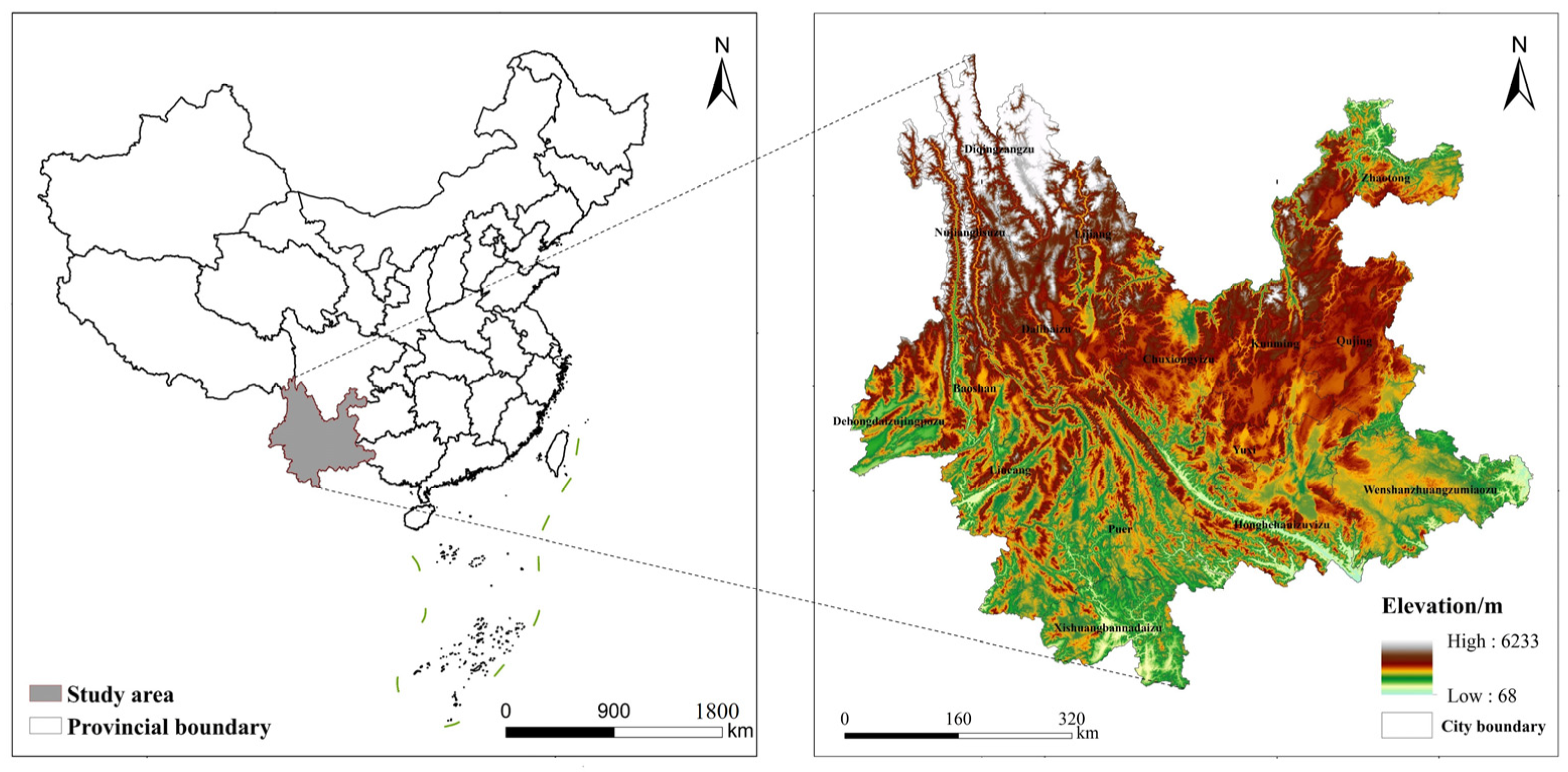


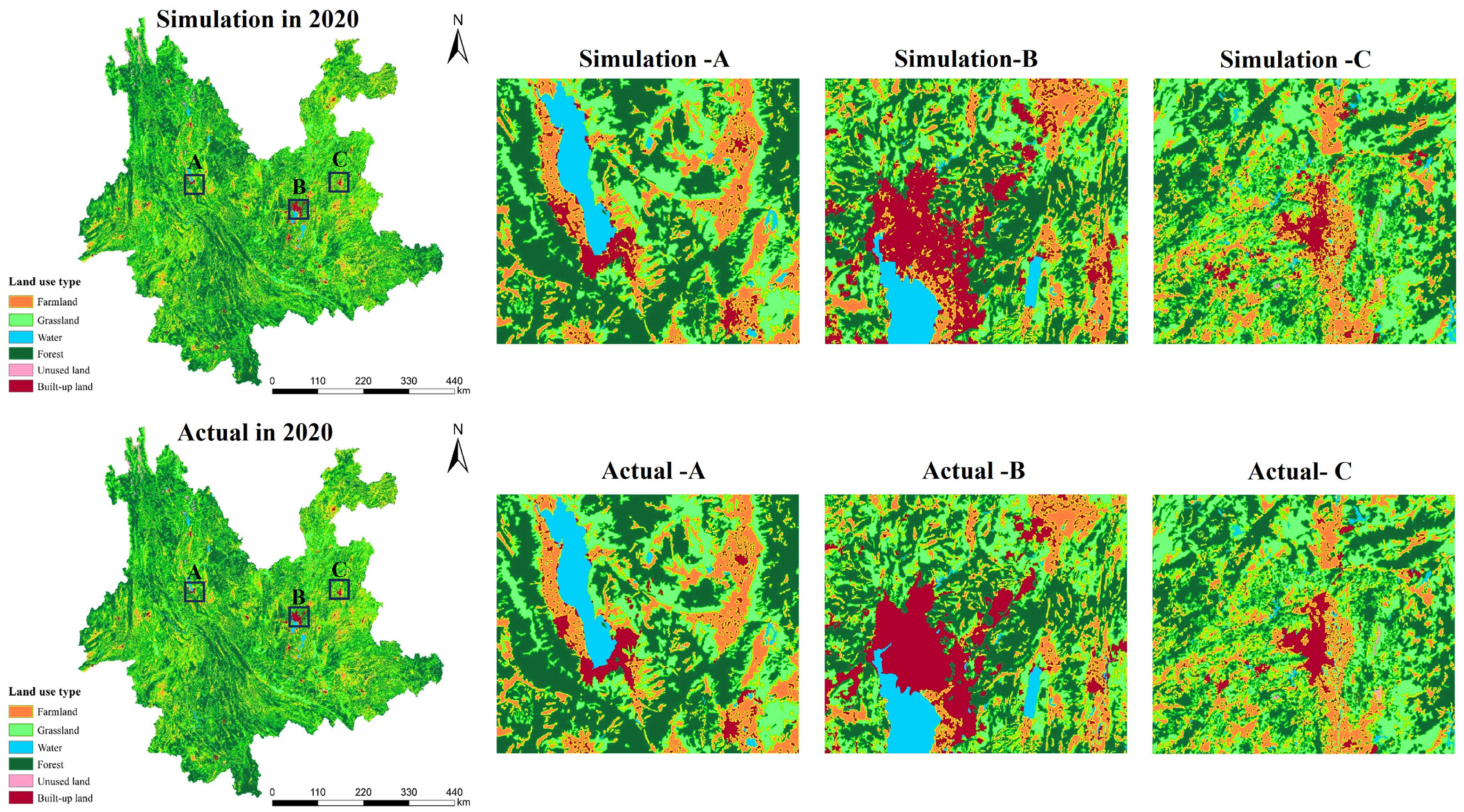
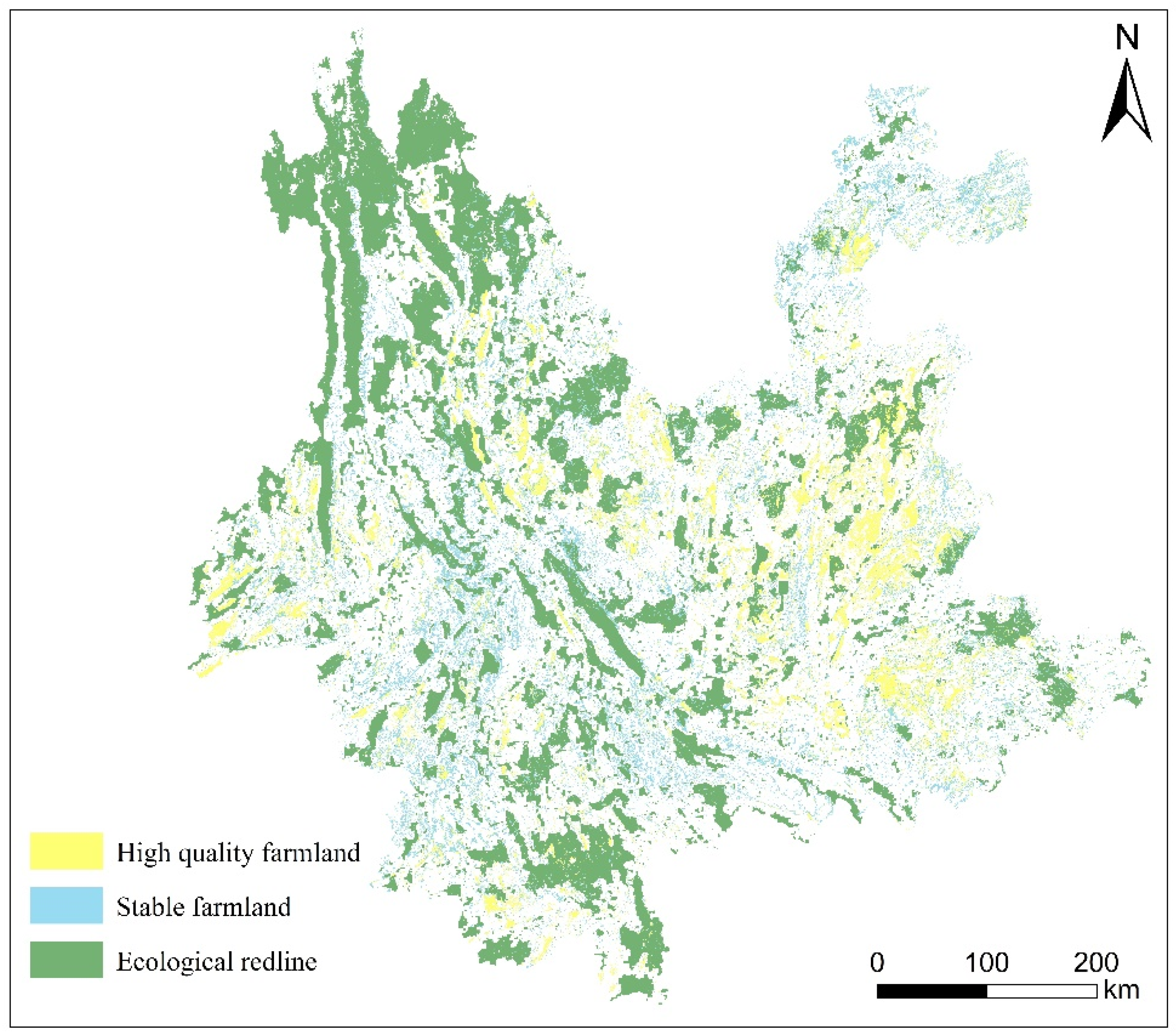

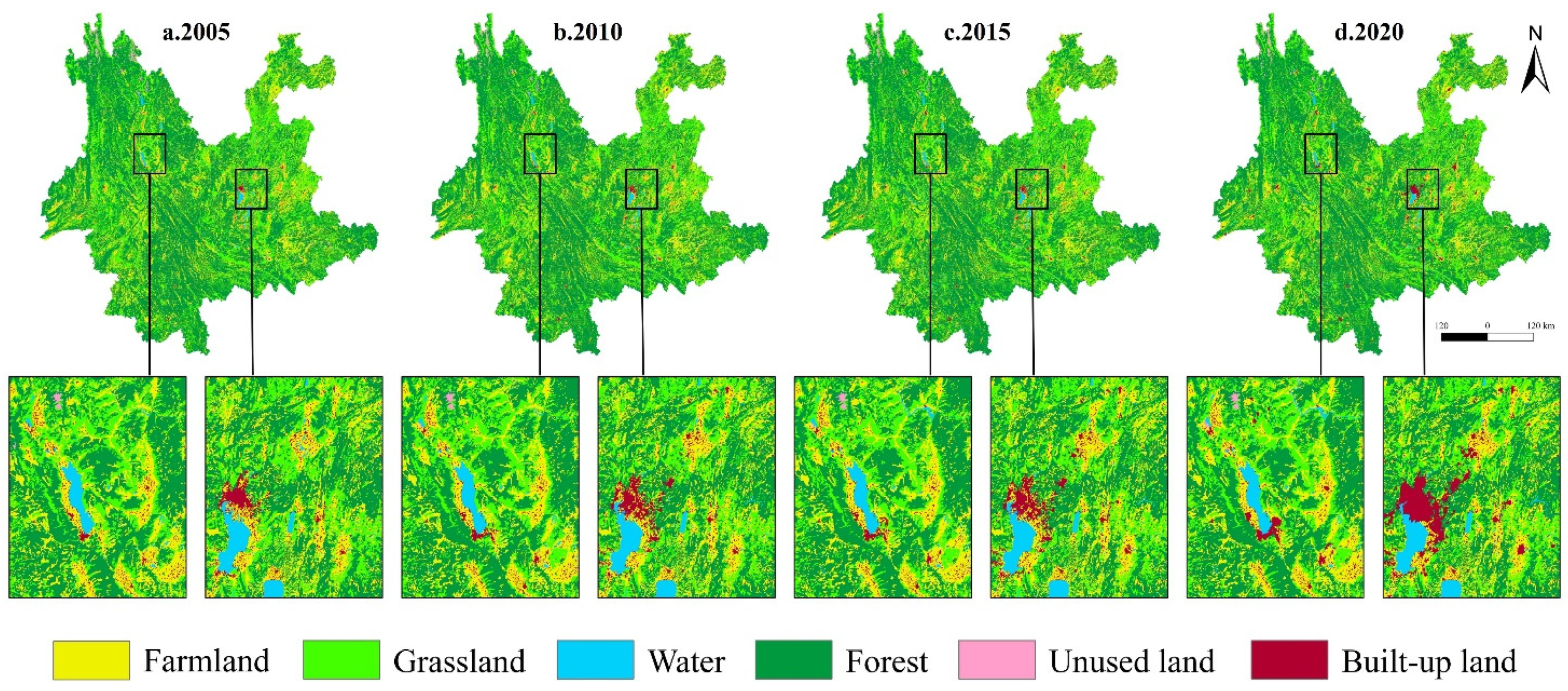
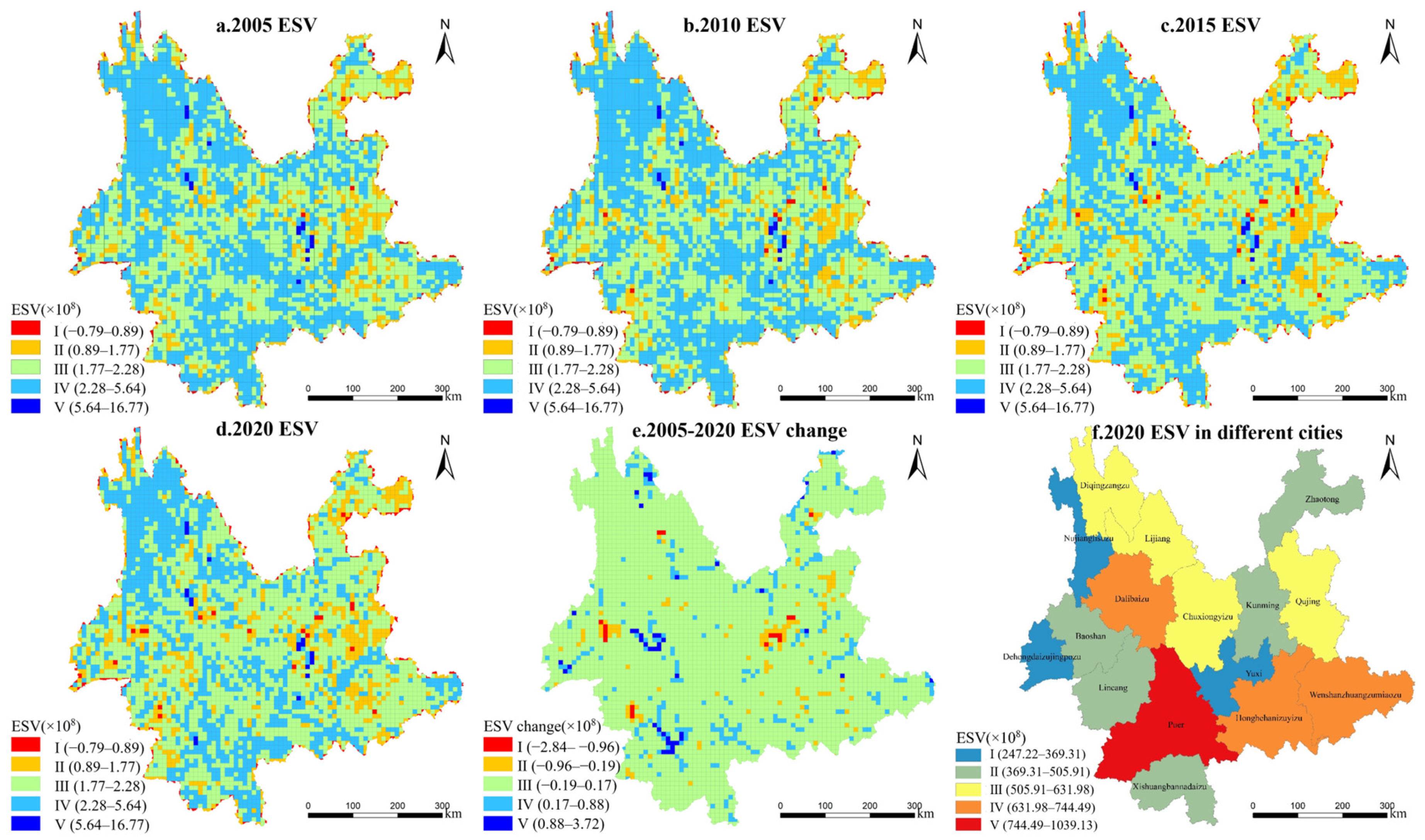
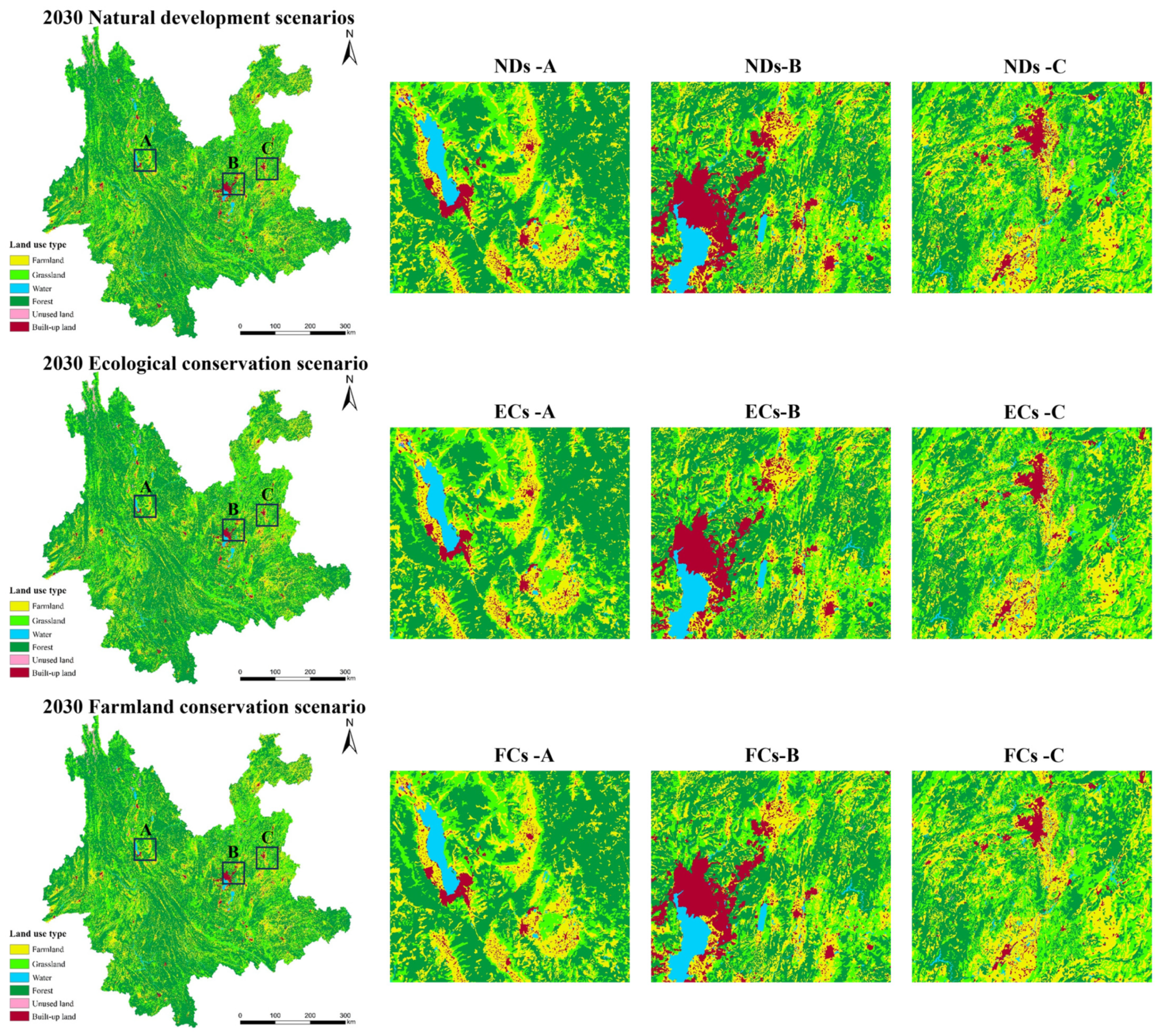
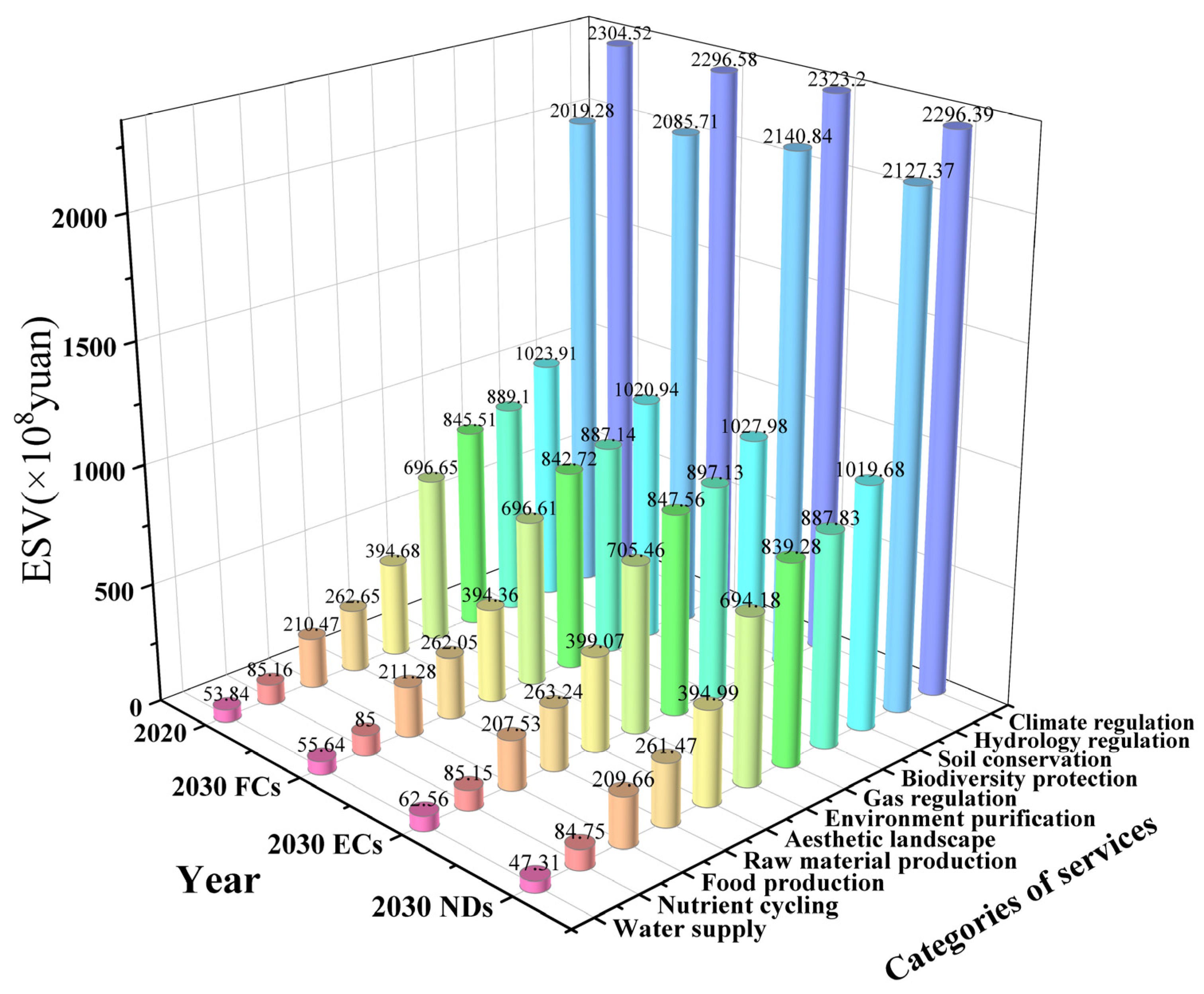
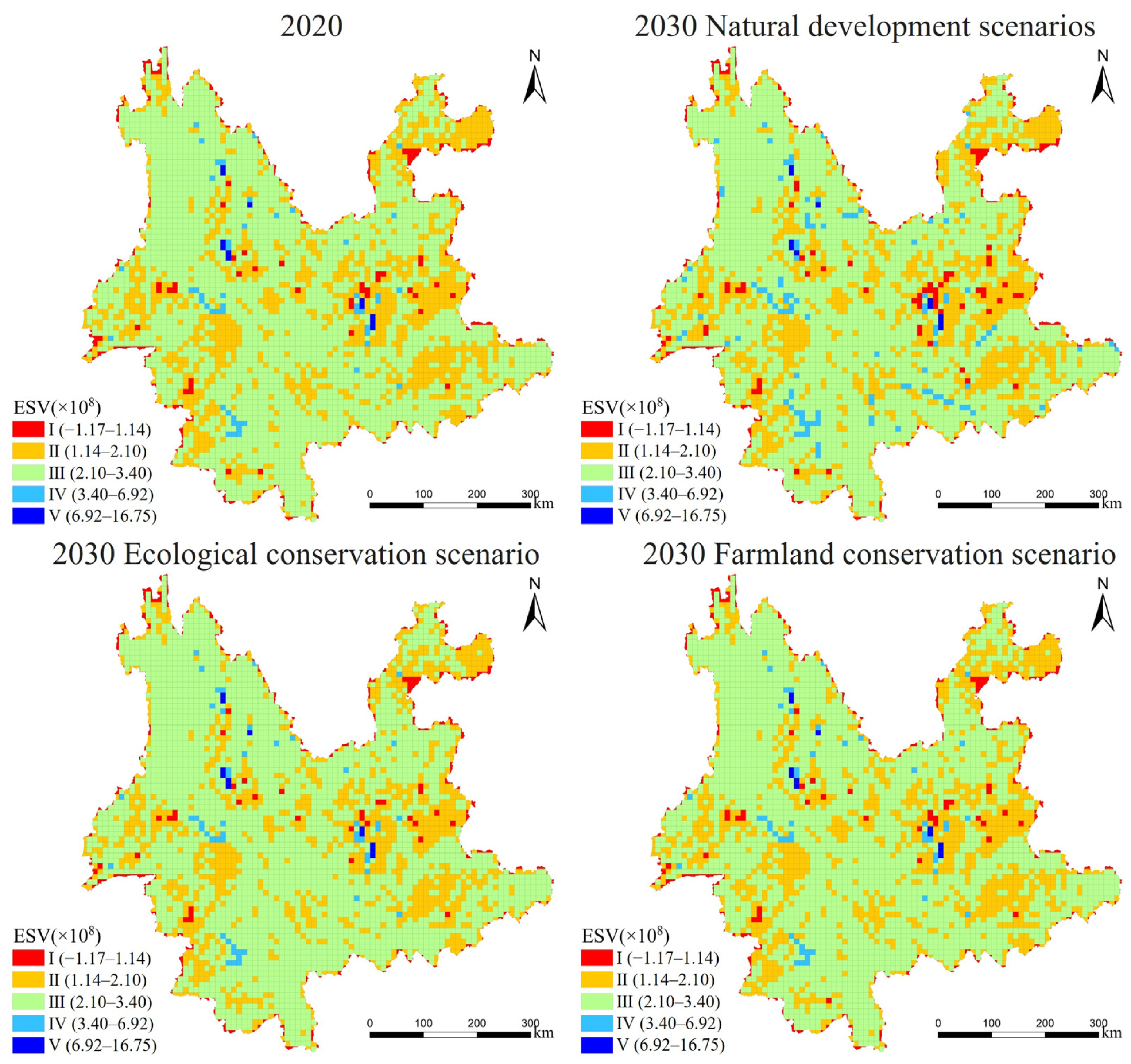

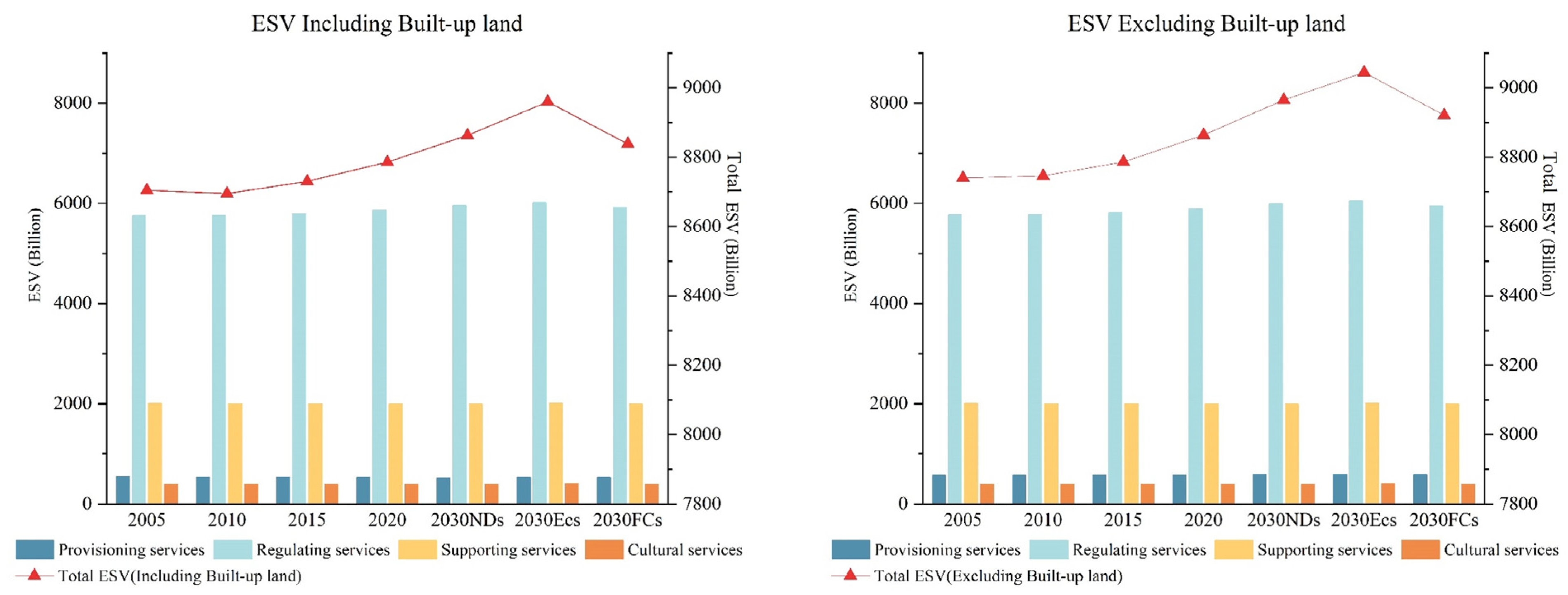
| Data | Format | Spatial Resolution | Data Source |
|---|---|---|---|
| Land Use/Land Cover (LULC) (Acquisition dates 2005, 2010, 2015, 2020) | Grid | 30 m | http://www.resdc.cn/ (accessed on 10 November 2024). (Landsat-TM/Landsat-8) |
| Precipitation | Grid | 1 km | http://www.resdc.cn/ (accessed on 10 November 2024). |
| Temperature | Grid | 1 km | http://www.resdc.cn/ (accessed on 10 November 2024). |
| Evapotranspiration | Grid | 1 km | http://www.resdc.cn/ (accessed on 10 November 2024). |
| Soil type | Grid | 1 km | http://www.resdc.cn/ (accessed on 10 November 2024). |
| Normalized Difference Vegetation Index | Grid | 1 km | http://www.resdc.cn/ (accessed on 10 November 2024). |
| Nighttime light | Grid | 1 km | http://www.resdc.cn/ (accessed on 10 November 2024). |
| Population | Grid | 1 km | http://www.resdc.cn/ (accessed on 10 November 2024). |
| GDP | Grid | 1 km | http://www.resdc.cn/ (accessed on 10 November 2024). |
| DEM | Grid | 30 m | https://www.gscloud.cn (accessed on 10 November 2024). |
| Highway | Shapefile | - | https://www.openstreetmap.org (accessed on 10 November 2024). |
| Railway | Shapefile | - | |
| Crops statistics Environmental statistics | Text | - | http://stats.yn.gov.cn/list19.aspx (accessed on 10 November 2024). https://www.stats.gov.cn/ (accessed on 10 November 2024). https://www.stats.gov.cn/sj/ndsj/2020/indexch.htm (accessed on 10 November 2024). |
| Ecosystem Service Categories | Farmland | Forest | Grassland | Water | Built-Up Land | Unused Land | |
|---|---|---|---|---|---|---|---|
| Provisioning services | Food production | 1334.37 | 341.14 | 476.02 | 1092.07 | 0 | 0 |
| Raw material production | 440.24 | 778.55 | 701.51 | 313.97 | 0 | 0 | |
| Water supply | −877.07 | 403.53 | 388.34 | 11,316.58 | −10,999.75 | 0 | |
| Regulating services | Gas regulation | 1064.77 | 2569.78 | 2467.81 | 1051.12 | −1756.033 | 27.3 |
| Climate regulation | 563.1 | 7693.91 | 6526.54 | 3126.05 | 0 | 0 | |
| Environment purification | 160.4 | 2222.32 | 2154.64 | 7576.24 | −3738.105 | 136.51 | |
| Hydrology regulation | 1204.69 | 4506.69 | 4785.29 | 139,566.61 | 0 | 40.95 | |
| Supporting services | Soil conservation | 1057.94 | 3129.62 | 3006.47 | 1269.53 | 27.3 | 27.3 |
| Nutrient cycling | 187.7 | 239.5 | 225.49 | 95.56 | 0 | 0 | |
| Biodiversity protection | 204.76 | 2848.53 | 2730.87 | 3480.97 | 27.3 | 27.3 | |
| Cultural services | Aesthetic landscape | 92.14 | 1249.84 | 1202.59 | 2580.02 | 13.65 | 13.65 |
| Land Use Type | 2005 | 2010 | 2015 | 2020 | ESV Change 2005–2020 | |
|---|---|---|---|---|---|---|
| Farmland | 374.02 | 373.41 | 372.07 | 367.52 | −6.50 | |
| Forest | 5691.04 | 5735.45 | 5728.87 | 5716.65 | 25.61 | |
| Grassland | 2192.40 | 2142.33 | 2139.09 | 2122.87 | −69.54 | |
| Water | 482.01 | 494.18 | 545.94 | 656.50 | 174.48 | |
| Built-up land | −35.80 | −50.88 | −56.31 | −78.18 | −42.38 | |
| Unused land | 0.58 | 0.43 | 0.43 | 0.42 | −0.16 | |
| Ecosystem service categories | 2005 | 2010 | 2015 | 2020 | ESV change 2005–2020 | |
| Provisioning services | Food production | 211.96 | 211.50 | 211.36 | 210.47 | −1.49 |
| Raw material production | 264.07 | 263.95 | 263.64 | 262.65 | −1.42 | |
| Water supply | 70.36 | 61.06 | 60.91 | 53.84 | −16.52 | |
| Regulating services | Gas regulation | 854.69 | 852.40 | 850.90 | 845.51 | −9.17 |
| Climate regulation | 2312.83 | 2312.89 | 2310.89 | 2304.52 | −8.31 | |
| Environment purification | 702.74 | 699.18 | 699.34 | 696.65 | −6.09 | |
| Hydrology regulation | 1887.78 | 1895.51 | 1935.57 | 2019.28 | 131.51 | |
| Supporting services | Soil conservation | 1029.22 | 1028.44 | 1027.39 | 1023.91 | −5.31 |
| Nutrient cycling | 85.69 | 85.63 | 85.52 | 85.16 | −0.53 | |
| Biodiversity protection | 890.63 | 890.19 | 890.12 | 889.10 | −1.54 | |
| Cultural services | Aesthetic landscape | 394.29 | 394.17 | 394.45 | 394.68 | 0.38 |
| Total | 8704.26 | 8694.91 | 8730.09 | 8785.78 | 81.52 | |
| Land Use Type | Farmland | Forest | Grassland | Water | Built-Up Land | Unused Land | Total |
|---|---|---|---|---|---|---|---|
| 2030 NDs | 362.94 | 5697.99 | 2105.02 | 798.77 | −102.22 | 0.42 | 8862.92 |
| 2030 ECs | 350.67 | 5837.12 | 2055.31 | 800.87 | −84.66 | 0.42 | 8959.72 |
| 2030 FCs | 370.87 | 5698.76 | 2105.45 | 745.16 | −82.61 | 0.42 | 8838.05 |
Disclaimer/Publisher’s Note: The statements, opinions and data contained in all publications are solely those of the individual author(s) and contributor(s) and not of MDPI and/or the editor(s). MDPI and/or the editor(s) disclaim responsibility for any injury to people or property resulting from any ideas, methods, instructions or products referred to in the content. |
© 2025 by the authors. Licensee MDPI, Basel, Switzerland. This article is an open access article distributed under the terms and conditions of the Creative Commons Attribution (CC BY) license (https://creativecommons.org/licenses/by/4.0/).
Share and Cite
Zhang, C.; Wang, Z.; Du, H.; Li, H. Response of Ecosystem Service Value to LULC Under Multi-Scenario Simulation Considering Policy Spatial Constraints: A Case Study of an Ecological Barrier Region in China. Land 2025, 14, 601. https://doi.org/10.3390/land14030601
Zhang C, Wang Z, Du H, Li H. Response of Ecosystem Service Value to LULC Under Multi-Scenario Simulation Considering Policy Spatial Constraints: A Case Study of an Ecological Barrier Region in China. Land. 2025; 14(3):601. https://doi.org/10.3390/land14030601
Chicago/Turabian StyleZhang, Chen, Zhanqi Wang, Hanwen Du, and Haiyang Li. 2025. "Response of Ecosystem Service Value to LULC Under Multi-Scenario Simulation Considering Policy Spatial Constraints: A Case Study of an Ecological Barrier Region in China" Land 14, no. 3: 601. https://doi.org/10.3390/land14030601
APA StyleZhang, C., Wang, Z., Du, H., & Li, H. (2025). Response of Ecosystem Service Value to LULC Under Multi-Scenario Simulation Considering Policy Spatial Constraints: A Case Study of an Ecological Barrier Region in China. Land, 14(3), 601. https://doi.org/10.3390/land14030601




